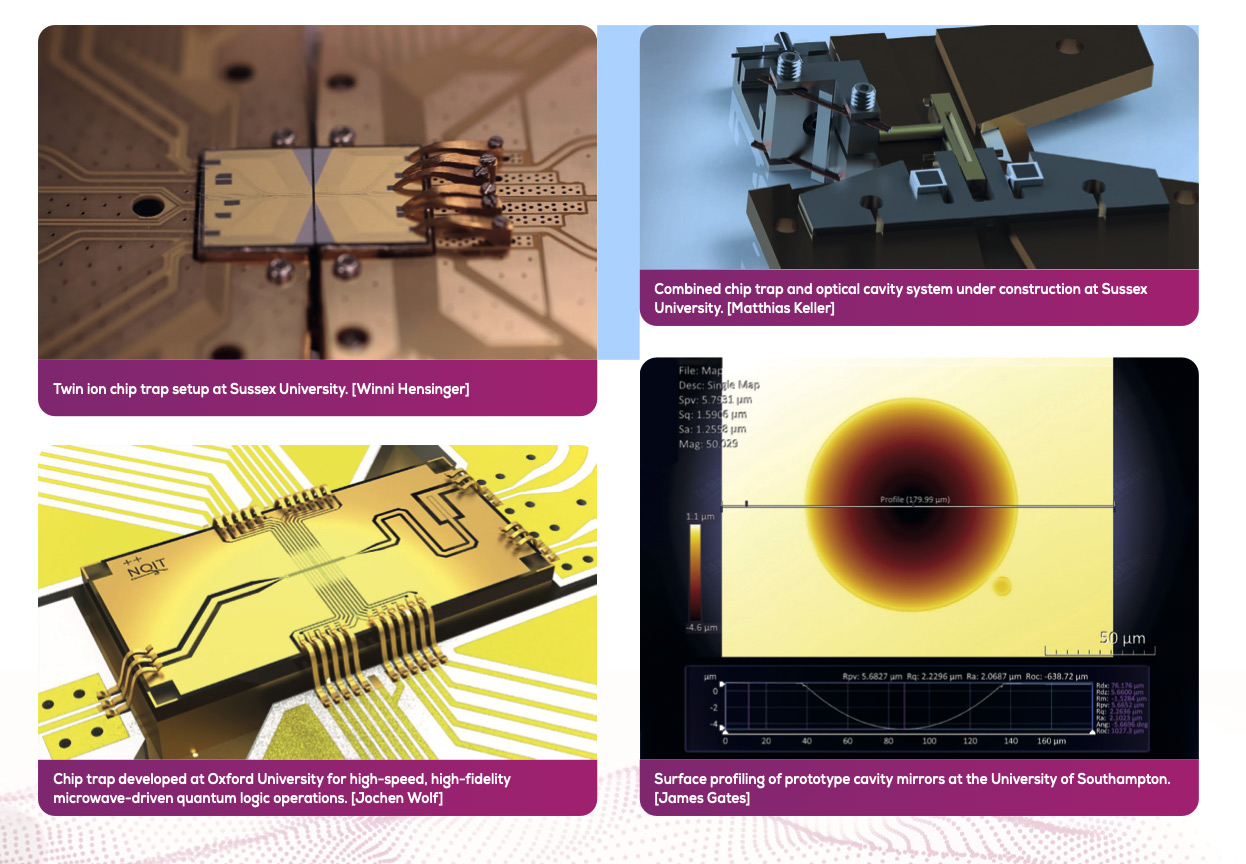Spotlight on.... Ion Traps
Spotlight on... Ion traps
Trapped atomic ions are the most mature qubit platform, benefitting from more than two decades of research and development since the first entangling logic gates were demonstrated in the late 1990s. They are pursued worldwide in universities, national labs and industrial settings. Here we take a look at the Hub's activities in this area.
The Hub’s work on ion traps focuses on using individual atomic ions trapped in microfabricated chip traps. Trapped ions constitute atomically perfect identical qubits, and can be manipulated with laser beams or microwave electronics to make elementary quantum logic gates of the highest possible precision. However, it is recognized that the long-term goal of universal fault-tolerant quantum computing will require both higher logic gate fidelities than the present state-of-the-art (around 99.9%) and methods of scaling up to large numbers of qubits; the Hub’s research addresses both of these challenges.
Our ion trap work is led from Oxford, and involves co-investigators at Imperial College, London, Southampton and Sussex universities.
Logic gates
We extended our earlier work on high-fidelity laser-driven entangling gates from same-species ions to gates between different atomic elements, with world-leading precision, and performed a comparative benchmarking study of the entangling operation [0]. We have proposed methods for making microwave-driven gates more robust to typical noise sources [1]. We have also investigated methods for diagnosing motional coherence (on which ion trap quantum logic operations usually depend) [2].
Chip trap development
A cryogenic system based around a microfabricated chip trap has been constructed for the purpose of increasing the speed of microwave-driven gates [3]; preliminary data show the gate speed is at least ten times faster than our previous results. We have constructed a dual chip-trap system as a demonstrator for beyond-single- chip scalability, and shuttled a qubit back and forth between the chips at high speed (<1ms), achieving millions of transfers without loss [4].
Quantum networking
A central theme of our research is the optical networking of trapped-ion qubits, by linking together trap modules using single photons of light in optical fibres. As well as a promising method for distributed computing and modular scaling, the techniques have applications in quantum communications and metrology. The two-node network which we constructed in the Phase 1 NQIT Hub demonstrated a world- leading combination of fidelity and rate of remote entanglement generation, across all physical platforms [5]. We used this system to make the first full demonstration of a “device-independent” quantum key distribution protocol, where the security is derived from the use of entangled qubits with minimal assumptions about the behaviour of the physical apparatus [6]. We also made the first demonstration of “entangled atomic clocks”, enabling an improvement in the precision of clock frequency comparison close to the Heisenberg Limit (the ultimate limit allowed by quantum mechanics) [7]. Recently, we have shown that our mixed-species logic gates can be used to couple an interface qubit to a memory qubit, extending the memory coherence time in a network node to around 100 seconds [8].
Optical cavities
The integration of optical cavity technology with ion traps will enable a step-change in the efficiency of ion-photon coupling, which could in turn
boost networked entanglement rates towards MHz speeds. It can also give access to infra-red photons suitable for longer-distance optical fibre links.
We have demonstrated enhanced ion-cavity coupling using cavity cooling techniques [9]. We have also studied theoretically the use of non-spherical
cavity mirrors and shown that this can enhance the atom/cavity coupling [10]. We are developing fabrication techniques to enable the precise integration of miniature optical cavities with microfabricated ion traps.

Ion trap partnership projects
The core activity of our ion trap work has been supplemented by several Partnership Resource Projects, for example: an industrial PRF “CaQTUS” (with Oxford Ionics Ltd) to develop a quick-turnaround system for testing chip traps, and an academic PRF “SQUARE” to develop a photonic waveguide chip for laser-addressing an array of ions in a single trap. The Quantum Communications Hub has also provided PRF funding to investigate increasing the range of the device-independent QKD demonstration to longer fibre links.
[0] A.C.Hughes et al., Phys. Rev. Lett. 125 080504 (2020).
[1] C.H.Valahu et al., New J.Phys. 23 113012 (2021).
[2] O.Corfield et al., PRX Quantum 2 040359 (2021).
[3] M.A.Weber et al., arXiv:2207.11364 (2022).
[4] M.Akhtar et al., arXiv:2203.14062 (2022).
[5] L.J.Stephenson, D.P.Nadlinger et al., Phys.Rev.Lett. 124 110501 (2020). [6] D.P.Nadlinger et al., Nature 607 682 (2022).
[7] B.C.Nichol, R.Srinivas et al., Nature 609 689 (2022). [8] P.Drmota et al., arXiv:2210.11447 (2022).
[9] C.Christoforou et al., Sci.Rep. 10 15693 (2020).
[10] D.V.Karpov, P.Horak, arXiv:2110.05981 (2021).


